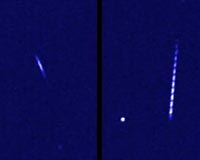 |
for NASA Science News Huntsville AL (SPX) Oct 29, 2010 This month, Comet Hartley 2 has put on a good show for backyard astronomers. The comet's vivid green atmosphere and auburn tail of dust look great through small telescopes, and NASA's Deep Impact/EPOXI probe is about to return even more dramatic pictures when it flies past the comet's nucleus on Nov. 4th. Another kind of show might be in the offing as well. Could this comet produce a meteor shower? "Probably not," says Bill Cooke of NASA's Meteoroid Environment Office, "but the other night we saw something that makes me wonder." On Oct 16th, a pair of NASA all-sky cameras caught an unusual fireball streaking across the night sky over Alabama and Georgia. It was bright, slow, and--here's what made it unusual--strangely similar to a fireball that passed over eastern Canada less than five hours earlier. The Canadian fireball was recorded by another set of all-sky cameras operated by the University of Western Ontario (UWO). Because the fireballs were recorded by multiple cameras, it was possible to triangulate their positions and backtrack their orbits before they hit Earth. This led to a remarkable conclusion: "The orbits of the two fireballs were very similar," Cooke says. "It's as if they came from a common parent." There's a candidate only 11 million miles away: Small but active Comet Hartley 2 is making one of the closest approaches to Earth of any comet in centuries. It turns out that the orbits of the two fireballs were not only similar to one another, but also roughly similar to the orbit of the comet. Moreover, meteoroids from Comet Hartley would be expected to hit Earth's atmosphere at a relatively slow speed--just like the two fireballs did. Cooke stresses that this could be a coincidence. "Thousands of meteoroids hit Earth's atmosphere every night. Some of them are bound to look like 'Hartley-ids' just by pure chance." Even so, he plans to keep an eye out for more in the nights ahead, especially on Nov. 2nd and 3rd. That's when a potential Hartley-id meteor shower would be most intense, according to calculations by meteor expert Peter Brown of UWO. The comet was closest to Earth on Oct. 20th, but that's not necessarily the shower's peak-time. Cooke explains: "The comet has been sputtering space dust for thousands of years, making a cloud that is much bigger than the comet itself. Solar radiation pressure and planetary encounters cause the comet and the dust cloud to diverge-not a lot, but enough to make the date of the shower different from the date of the comet's closest approach." If there is a Hartley-id shower-"that's a big IF," notes Cooke--it would emanate from the constellation Cygnus the Swan, visible to observers in the northern hemisphere almost directly overhead after sunset in early November. Lunar interference should not be a problem. On Nov. 2nd and 3rd, the Moon will be a slender crescent, providing dark skies for a meteor watch. "I'll definitely have our cameras turned on," says Cooke. "It's probably going to be a non-event. On the other hand," he points out, "we might discover a whole new meteor shower."
Share This Article With Planet Earth
Related Links NASA Meteoroid Environment Office at Marshall Asteroid and Comet Impact Danger To Earth - News and Science
 NASA Cameras Spot Meteors From Obscure Camelopardalis Shower
NASA Cameras Spot Meteors From Obscure Camelopardalis ShowerWashington DC (SPX) Oct 12, 2010 It's a strange-sounding name for a constellation, coming from the Greco-Roman word for giraffe, or "camel leopard". The October Camelopardalids are a collection of faint stars that have no mythology associated with them - in fact, they didn't begin to appear on star charts until the 17th century. Even experienced amateur astronomers are hard-pressed to find the constellation in the night s ... read more |
|
| The content herein, unless otherwise known to be public domain, are Copyright 1995-2010 - SpaceDaily. AFP and UPI Wire Stories are copyright Agence France-Presse and United Press International. ESA Portal Reports are copyright European Space Agency. All NASA sourced material is public domain. Additional copyrights may apply in whole or part to other bona fide parties. Advertising does not imply endorsement,agreement or approval of any opinions, statements or information provided by SpaceDaily on any Web page published or hosted by SpaceDaily. Privacy Statement |